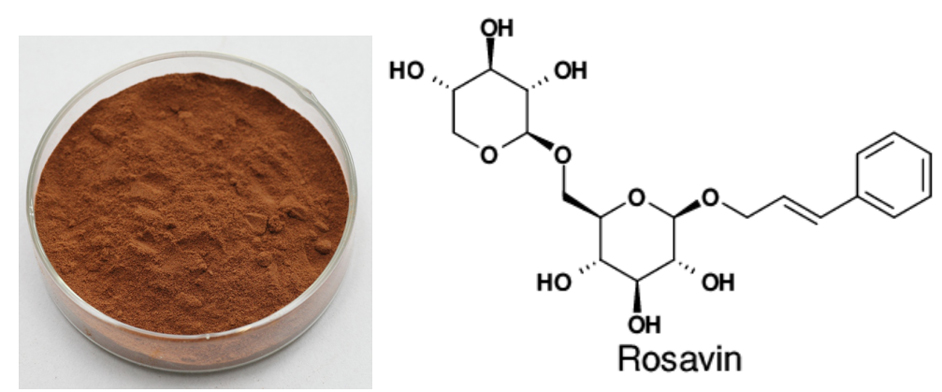Goods high definition for Rhodiola Rosea Extract Factory for Guinea
Goods high definition for Rhodiola Rosea Extract Factory for Guinea Detail:
[Latin Name] Rhodiola Rosea
[Plant Source] China
[Specifications] Salidrosides:1%-5%
Rosavin:3% HPLC
[Appearance] Brown fine powder
[Plant Part Used] Root
[Particle size] 80 Mesh
[Loss on drying] ≤5.0%
[Heavy Metal] ≤10PPM
[Storage] Store in cool & dry area, keep away from the direct light and heat.
[Package] Packed in paper-drums and two plastic-bags inside.
[What is Rhodiola Rosea]
Rhodiola Rosea (also known as Arctic root or golden root) is a member of the family Crassulaceae, a family of plants native to the arctic regions of Eastern Siberia. Rhodiola rosea is widely distributed in Arctic and mountainous regions throughout Europe and Asia. It grows at altitudes of 11,000 to 18,000 feet above sea level.
There are numerous animal and test tube studies showing that rhodiola has both a stimulating and a sedating effect on the central nervous system; enhance physical endurance; improves thyroid, thymus, and adrenal function; protects the nervous system, heart and liver; and has antioxidant and anticancer properties.
[Function]
1 Enhancing immunity and delaying aging;
2 Resisting radiation and tumor;
3 Regulating nervous system and metabolism, effectively limiting melancholy feeling and mood, and promoting mental status;
4 Protecting cardiovascular, dilating coronary artery,preventing coronary arteriosclerosis and arrhythmia.
Product detail pictures:

Related Product Guide:
We hold strengthening and perfecting our items and repair. At the same time, we get the job done actively to do research and progress for Goods high definition for Rhodiola Rosea Extract Factory for Guinea , The product will supply to all over the world, such as: Georgia, Yemen, Uruguay, Our production have been exported to more than 30 countries and regions as first hand source with lowest price. We sincerely welcome customers from both at home and abroad to come to negotiate business with us.
The “BERRY SUNDAE” recipe in this Episode packs a serious punch when it comes to keeping you sharp for 5 hours!
Its probably the BEST Ice Cream you can have for BREAKFAST!
Researchers found that a large helping of BLUBERRIES boosts concentration and memory up to five hours later!!!
In tests, volunteers who drank a blueberry smoothie in the morning did much better at mental tasks in the mid-afternoon than people who had an alternative drink.
British scientists who made the discovery believe the antioxidants in blueberries stimulate the flow of blood and oxygen to the brain – and keep the mind fresh.
The researchers believe that flavonoids in berries activate an enzyme in the body called Enos which increases the flow of blood and oxygen to the brain.
Blueberries contain a cocktail of anti-oxidants including anthocyanins, proanthocyanidins, resveratrol and tannins.
Are you hungry yet?
https://www.facebook.com/DanielRBissonnette/?fref=ts
https://www.dailymail.co.uk/health/article-1212579/A-bowl-blueberries-day-keeps-brain-active-afternoon.html
QAAFI SCIENCE SEMINAR SERIES
4 April 2017
DESCRIPTION
Cardiovascular disease (CVD) is one of the main causes of death and contribute significantly to high health burden worldwide. It is estimated that 17 million people die every year from CVD, and in Australia it represents 37% of all deaths. Risk factors causing heart diseases are obesity, tobacco smoking, inactivity and unhealthy diets according to WHO (2011). One of the strategies to lower the prevalence of CVD is to promote healthy eating via increasing the daily consumption of cereals, fruits, and vegetables. Population based studies have shown that diet is strongly associated with heart diseases, and these days a very important lifestyle change is the ‘heart-healthy’ diet which includes the consumption of soluble dietary fibres (SDF) from cereals for example. Although SDFs in intervention trials have been shown to decrease blood cholesterol and/or triglycerides, risk biomarkers for CVD, the detailed mechanism(s) are not yet defined, but restricted re-absorption of bile acids (BAs) resulting in an excess excretion in the faeces has been hypothesised.
In the Centre for Nutrition and Food Sciences (CNAFS) we have been studying the mechanisms behind the lipid lowering effects of SDFs such as β-glucan from oat and barley; and arabinoxylan from wheat and rye using in vitro, ex vivo and in vivo approaches. Using pigs as a model for humans, we found out that after an adaptation period on the test diets, (1) oat β-glucan not only physically hinders the active transport of bile acids and uptake of cholesterol, but also changes the BAs profile, thus resulting in reduced blood total and LDL-cholesterol. (2) Wheat arabinoxylan on the other hand, lowers blood triglycerides with delay in digestion and absorption of triglycerides from the small intestine to the blood circulation. In both experiments, lower circulating BAs levels, enhanced production of therapeutic and suppression of toxic BAs were seen without excess excretion of BAs in the faeces.
About Dr Nima Gunness
Dr Nima Gunness is a Postdoctoral Research Fellow at the Centre for Nutrition and Food Sciences (CNAFS), ARC Centre in Excellence in Plant Cell Walls. Nima was awarded a PhD in Nutrition, Biochemistry and Food Sciences from the University of Queensland, QLD, Australia after graduating with a Master in Food Technology degree from Curtin University, WA, Australia. Nima has a BSc in Biology from the University of Provence, Aix Marseille I, France.
Nima’s research interests include understanding and proposing solutions towards two major public health concerns cardiovascular disease and obesity via healthy eating. In her current role, Nima has been investigating the mechanisms behind the lipid-reducing properties of non-starch polysaccharides/soluble dietary fibres from cereals (e.g. oat, barley, wheat and rye) by investigating the structure/function of soluble dietary fibres in relation to their interactions with cholesterol, triglycerides and bile acids using in vitro, ex vivo and in vivo methods. She is also working on the nutritional mechanisms underpinning the epidemiological health benefits of whole fruit, vegetables and nuts, to translate these into consumer concepts (e.g. satiety per kJ and satiation). Nima has published a number of scientific articles in renowned international journals as first author, a review which is highly cited and a recent publication which has attracted media attention. Nima mentors PhD, Master, Honours and Overseas visiting students. Nima is part of the Project Leadership Team of the ARC CoE in Plant Cell Walls.
SUBSCRIBE:
https://www.vision6.com.au/em/forms/subscribe.php?db=398137&s=117697&a=45549&k=387aedc
WEB: https://qaafi.uq.edu.au/
Staff is skilled, well-equipped, process is specification, products meet the requirements and delivery is guaranteed, a best partner!







